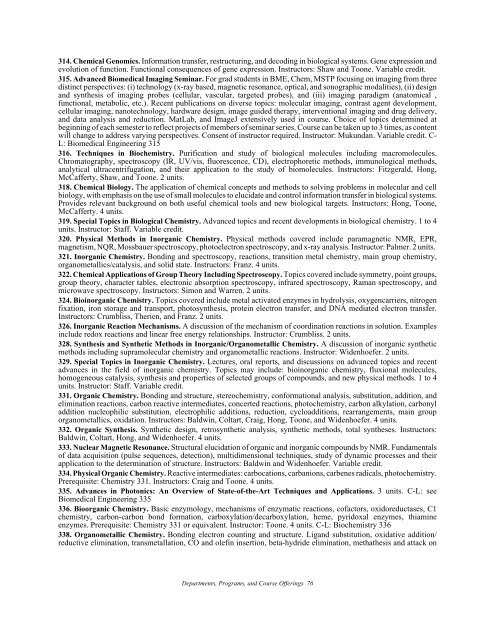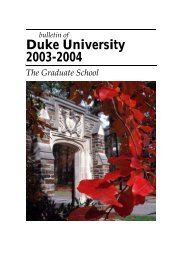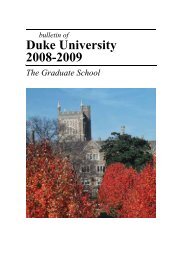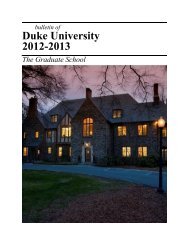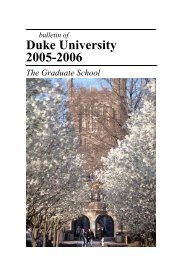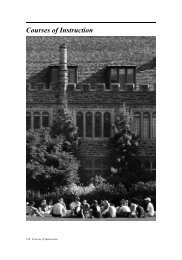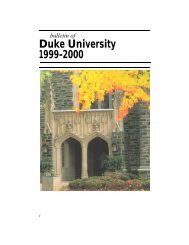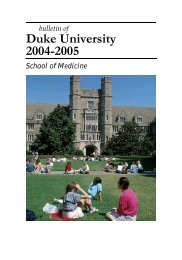Duke University 2009-2010 - Office of the Registrar - Duke University
Duke University 2009-2010 - Office of the Registrar - Duke University
Duke University 2009-2010 - Office of the Registrar - Duke University
Create successful ePaper yourself
Turn your PDF publications into a flip-book with our unique Google optimized e-Paper software.
314. Chemical Genomics. Information transfer, restructuring, and decoding in biological systems. Gene expression and<br />
evolution <strong>of</strong> function. Functional consequences <strong>of</strong> gene expression. Instructors: Shaw and Toone. Variable credit.<br />
315. Advanced Biomedical Imaging Seminar. For grad students in BME, Chem, MSTP focusing on imaging from three<br />
distinct perspectives: (i) technology (x-ray based, magnetic resonance, optical, and sonographic modalities), (ii) design<br />
and syn<strong>the</strong>sis <strong>of</strong> imaging probes (cellular, vascular, targeted probes), and (iii) imaging paradigm (anatomical ,<br />
functional, metabolic, etc.). Recent publications on diverse topics: molecular imaging, contrast agent development,<br />
cellular imaging, nanotechnology, hardware design, image guided <strong>the</strong>rapy, interventional imaging and drug delivery,<br />
and data analysis and reduction. MatLab, and ImageJ extensively used in course. Choice <strong>of</strong> topics determined at<br />
beginning <strong>of</strong> each semester to reflect projects <strong>of</strong> members <strong>of</strong> seminar series. Course can be taken up to 3 times, as content<br />
will change to address varying perspectives. Consent <strong>of</strong> instructor required. Instructor: Mukundan. Variable credit. C-<br />
L: Biomedical Engineering 315<br />
316. Techniques in Biochemistry. Purification and study <strong>of</strong> biological molecules including macromolecules.<br />
Chromatography, spectroscopy (IR, UV/vis, fluorescence, CD), electrophoretic methods, immunological methods,<br />
analytical ultracentrifugation, and <strong>the</strong>ir application to <strong>the</strong> study <strong>of</strong> biomolecules. Instructors: Fitzgerald, Hong,<br />
McCafferty, Shaw, and Toone. 2 units.<br />
318. Chemical Biology. The application <strong>of</strong> chemical concepts and methods to solving problems in molecular and cell<br />
biology, with emphasis on <strong>the</strong> use <strong>of</strong> small molecules to elucidate and control information transfer in biological systems.<br />
Provides relevant background on both useful chemical tools and new biological targets. Instructors: Hong, Toone,<br />
McCafferty. 4 units.<br />
319. Special Topics in Biological Chemistry. Advanced topics and recent developments in biological chemistry. 1 to 4<br />
units. Instructor: Staff. Variable credit.<br />
320. Physical Methods in Inorganic Chemistry. Physical methods covered include paramagnetic NMR, EPR,<br />
magnetism, NQR, Mossbauer spectroscopy, photoelectron spectroscopy, and x-ray analysis. Instructor: Palmer. 2 units.<br />
321. Inorganic Chemistry. Bonding and spectroscopy, reactions, transition metal chemistry, main group chemistry,<br />
organometallics/catalysis, and solid state. Instructors: Franz. 4 units.<br />
322. Chemical Applications <strong>of</strong> Group Theory Including Spectroscopy. Topics covered include symmetry, point groups,<br />
group <strong>the</strong>ory, character tables, electronic absorption spectroscopy, infrared spectroscopy, Raman spectroscopy, and<br />
microwave spectroscopy. Instructors: Simon and Warren. 2 units.<br />
324. Bioinorganic Chemistry. Topics covered include metal activated enzymes in hydrolysis, oxygencarriers, nitrogen<br />
fixation, iron storage and transport, photosyn<strong>the</strong>sis, protein electron transfer, and DNA mediated electron transfer.<br />
Instructors: Crumbliss, Therien, and Franz. 2 units.<br />
326. Inorganic Reaction Mechanisms. A discussion <strong>of</strong> <strong>the</strong> mechanism <strong>of</strong> coordination reactions in solution. Examples<br />
include redox reactions and linear free energy relationships. Instructor: Crumbliss. 2 units.<br />
328. Syn<strong>the</strong>sis and Syn<strong>the</strong>tic Methods in Inorganic/Organometallic Chemistry. A discussion <strong>of</strong> inorganic syn<strong>the</strong>tic<br />
methods including supramolecular chemistry and organometallic reactions. Instructor: Widenhoefer. 2 units.<br />
329. Special Topics in Inorganic Chemistry. Lectures, oral reports, and discussions on advanced topics and recent<br />
advances in <strong>the</strong> field <strong>of</strong> inorganic chemistry. Topics may include: bioinorganic chemistry, fluxional molecules,<br />
homogeneous catalysis, syn<strong>the</strong>sis and properties <strong>of</strong> selected groups <strong>of</strong> compounds, and new physical methods. 1 to 4<br />
units. Instructor: Staff. Variable credit.<br />
331. Organic Chemistry. Bonding and structure, stereochemistry, conformational analysis, substitution, addition, and<br />
elimination reactions, carbon reactive intermediates, concerted reactions, photochemistry, carbon alkylation, carbonyl<br />
addition nucleophilic substitution, electrophilic additions, reduction, cycloadditions, rearrangements, main group<br />
organometallics, oxidation. Instructors: Baldwin, Coltart, Craig, Hong, Toone, and Widenhoefer. 4 units.<br />
332. Organic Syn<strong>the</strong>sis. Syn<strong>the</strong>tic design, retrosyn<strong>the</strong>tic analysis, syn<strong>the</strong>tic methods, total syn<strong>the</strong>ses. Instructors:<br />
Baldwin, Coltart, Hong, and Widenhoefer. 4 units.<br />
333. Nuclear Magnetic Resonance. Structural elucidation <strong>of</strong> organic and inorganic compounds by NMR. Fundamentals<br />
<strong>of</strong> data acquisition (pulse sequences, detection), multidimensional techniques, study <strong>of</strong> dynamic processes and <strong>the</strong>ir<br />
application to <strong>the</strong> determination <strong>of</strong> structure. Instructors: Baldwin and Widenhoefer. Variable credit.<br />
334. Physical Organic Chemistry. Reactive intermediates: carbocations, carbanions, carbenes radicals, photochemistry.<br />
Prerequisite: Chemistry 331. Instructors: Craig and Toone. 4 units.<br />
335. Advances in Photonics: An Overview <strong>of</strong> State-<strong>of</strong>-<strong>the</strong>-Art Techniques and Applications. 3 units. C-L: see<br />
Biomedical Engineering 335<br />
336. Bioorganic Chemistry. Basic enzymology, mechanisms <strong>of</strong> enzymatic reactions, c<strong>of</strong>actors, oxidoreductases, C1<br />
chemistry, carbon-carbon bond formation, carboxylation/decarboxylation, heme, pyridoxal enzymes, thiamine<br />
enzymes. Prerequisite: Chemistry 331 or equivalent. Instructor: Toone. 4 units. C-L: Biochemistry 336<br />
338. Organometallic Chemistry. Bonding electron counting and structure. Ligand substitution, oxidative addition/<br />
reductive elimination, transmetallation, CO and olefin insertion, beta-hydride elimination, metha<strong>the</strong>sis and attack on<br />
Departments, Programs, and Course Offerings 76


